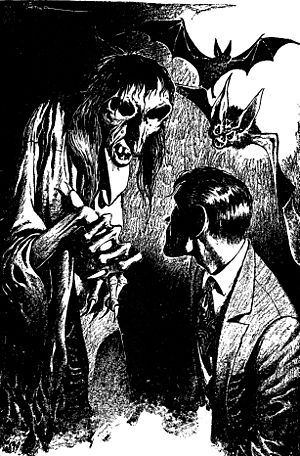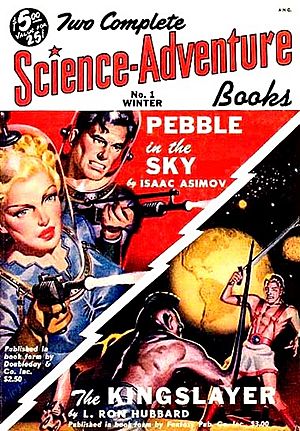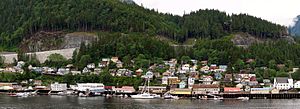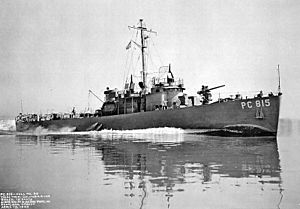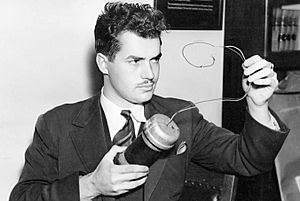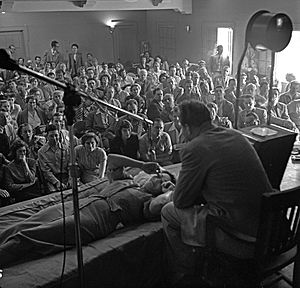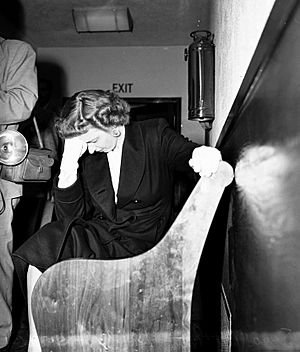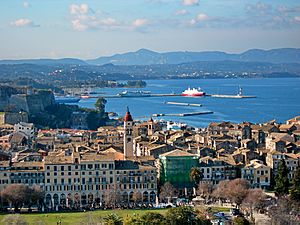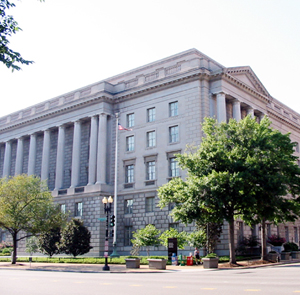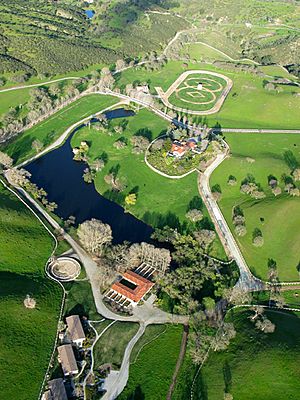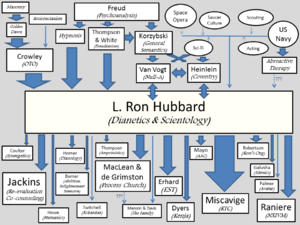L. Ron Hubbard facts for kids
Quick facts for kids
L. Ron Hubbard
|
|
|---|---|
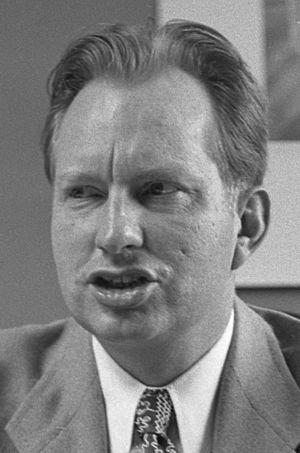
Hubbard in 1950
|
|
| Born |
Lafayette Ronald Hubbard
March 13, 1911 Tilden, Nebraska, U.S.
|
| Died | January 24, 1986 (aged 74) Creston, California, U.S.
|
| Education | George Washington University (dropped out) |
| Occupation | Author, religious leader |
| Known for | Inventor of Scientology |
|
Notable work
|
Dianetics: The Modern Science of Mental Health Battlefield Earth |
| Criminal charge(s) | Petty theft (in 1948), Fraud (in absentia, 1978) |
| Criminal penalty | Fine of ₣35,000 and four years in prison (unserved) |
| Spouse(s) |
Margaret "Polly" Grubb
(m. 1933; div. 1947)Mary Sue Whipp
(m. 1952) |
| Children | 7:
With Margaret Grubb:
With Sara Hollister:
With Mary Sue Whipp:
|
| Relatives | Jamie DeWolf (great-grandson) |
| Military career | |
| Allegiance | |
| Service/ |
|
| Years of service | 1941–1945 (Active) 1945–1950 (Reserve) |
| Rank | |
| Commands held | USS YP-422 and USS PC-815 |
| Battles/wars | World War II |
| Awards |
|
| Signature | |
Lafayette Ronald Hubbard (March 13, 1911 – January 24, 1986) was an American author, primarily of science fiction and fantasy stories, who is best known for having founded the Church of Scientology. In 1950, Hubbard authored Dianetics: The Modern Science of Mental Health and established a series of organizations to promote Dianetics. In 1952, Hubbard lost the rights to Dianetics in bankruptcy proceedings, and he subsequently founded Scientology. Thereafter, Hubbard oversaw the growth of the Church of Scientology into a worldwide organization.
Born in Tilden, Nebraska, in 1911, Hubbard spent much of his childhood in Helena, Montana. After his father was posted to the U.S. naval base on Guam, Hubbard traveled to Asia and the South Pacific in the late 1920s. In 1930, Hubbard enrolled at George Washington University to study civil engineering but dropped out in his second year. He began his career as a prolific writer of pulp fiction stories and married Margaret "Polly" Grubb, who shared his interest in aviation.
Hubbard was an officer in the Navy during World War II, where he briefly commanded two ships but was removed from command both times. The last few months of his active service were spent in a hospital, being treated for a variety of complaints.
In 1953, the first churches of Scientology were founded by L. Ron Hubbard, and in 1954 a Scientology church in Los Angeles was founded, which became the Church of Scientology International. Hubbard also added organizational management strategies, principles of pedagogy, a theory of communication and prevention strategies for healthy living to the teachings of Scientology.
Scientology became increasingly controversial during the 1960s and came under intense media, government and legal pressure in a number of countries. During the late 1960s and early 1970s, Hubbard spent much of his time at sea on his personal fleet of ships as "Commodore" of the Sea Organization, an elite quasi-paramilitary group of Scientologists.
Hubbard returned to the United States in 1975 and went into seclusion in the California desert after an unsuccessful attempt to take over the town of Clearwater, Florida. In 1978, Hubbard was convicted of fraud after he was tried in absentia by France. In the same year, eleven high-ranking members of Scientology were indicted on 28 charges for their role in the Church's Snow White Program, a systematic program of espionage against the United States government. One of the indicted was Hubbard's wife Mary Sue Hubbard, who was in charge of the program; L. Ron Hubbard was named an unindicted co-conspirator.
Hubbard spent the remaining years of his life in seclusion in a luxury motorhome on a ranch in California, attended to by a small group of Scientology officials. He died at age 74 in January 1986. Following Hubbard's death, Scientology leaders announced that his body had become an impediment to his work and that he had decided to "drop his body" to continue his research on another plane of existence. Though many of Hubbard's autobiographical statements have been found to be fictitious, the Church of Scientology describes Hubbard in hagiographic terms and rejects any suggestion that its account of Hubbard's life is not historical fact.
Contents
Early life
L. Ron Hubbard was born in 1911 in Tilden, Nebraska, the only child of Ledora May (née Waterbury), who had trained as a teacher, and Harry Ross Hubbard, a former United States Navy officer. After moving to Kalispell, Montana, they settled in Helena in 1913. Hubbard's father rejoined the Navy in April 1917, during World War I, while his mother worked as a clerk for the state government.
During the 1920s the Hubbards repeatedly relocated around the United States and overseas. Hubbard was active in the Boy Scouts in Washington, D.C. and earned the rank of Eagle Scout in 1924, two weeks after his 13th birthday.
In 1925, Hubbard was enrolled as a freshman at Union High School, Bremerton, and the following year studied at Queen Anne High School in Seattle.
In April 1927, Hubbard's father was posted to Guam, and that summer, Hubbard and his mother traveled to Guam with a brief stop-over in a couple of Chinese ports. He recorded his impressions of the places he visited and disdained the poverty of the inhabitants of Japan and China, whom he described as "gooks" and "lazy [and] ignorant".
In September 1927, while living with grandparents, Hubbard enrolled at Helena High School, where he contributed to the school paper. On May 11, 1928, Hubbard was dropped from enrollment at Helena High due to failing grades. Hubbard left Helena and rejoined his parents in Guam in June 1928.
Between October and December 1928, Hubbard's family and others traveled from Guam to China. Upon his return to Guam, Hubbard spent much of his time writing dozens of short stories and essays. Hubbard failed the Naval Academy entrance examination.
In September 1929, Hubbard was enrolled at the Swavely Preparatory School in Manassas, Virginia, to prepare him for a second attempt at the examination. During his first semester at Swevely, Hubbard complained of eye strain and was diagnosed with myopia; this diagnosis precluded any enrollment in the Naval Academy. As an adult, Hubbard would write to himself: "Your eyes are getting progressively better. They became bad when you used them as an excuse to escape the naval academy".
He was instead sent to Woodward School for Boys in Washington, D.C. to qualify for admission to George Washington University without having to sit for the entrance examination. He successfully graduated from the school in June 1930 and entered the University the following September.
Period at university and Caribbean trip
On September 24, 1930, Hubbard began studying civil engineering at George Washington University's School of Engineering, at the behest of his father. Academically, Hubbard did poorly: his transcripts show he failed many courses including atomic physics, though later in life he would claim to have been a nuclear physicist. In September 1931, he was placed on probation due to poor grades, and in April 1932 he again received a warning for his lack of academic achievement. During his first year, Hubbard helped organize the university Glider Club and was elected its president.
During what would become Hubbard's final semester at GWU, he organized an ill-fated trip to the Caribbean for June 1932 to explore and film the pirate "strongholds and bivouacs of the Spanish Main" and to "collect whatever one collects for exhibits in museums". Amid multiple misfortunes and running low on funds, the ship's owners ordered it to return to Baltimore. Hubbard failed to return to University the following year.
After his father volunteered him for a Red Cross relief effort, on October 23, 1932, Hubbard traveled to Puerto Rico. En route, Hubbard apparently "decided to abandon the Red Cross", instead opting to accompany a mineral surveyor in a futile bid to find gold.
First marriage and early literary career
Hubbard returned from Puerto Rico to D.C. in February 1933. He struck up a relationship with a fellow glider pilot named Margaret "Polly" Grubb. The two were married on April 13. She was already pregnant when they married, but had a miscarriage shortly afterwards; a few months later, she became pregnant again. On May 7, 1934, she gave birth prematurely to a son who was named Lafayette Ronald Hubbard, Jr., whose nickname was "Nibs". Their second child, Katherine May, was born on January 15, 1936. The Hubbards lived for a while in Laytonsville, Maryland, but were chronically short of money.
Hubbard became a well-known and prolific writer for pulp fiction magazines during the 1930s. His literary career began with contributions to the George Washington University student newspaper, The University Hatchet, as a reporter for a few months in 1931. Six of his pieces were published commercially during 1932 to 1933. The going rate for freelance writers at the time was only a cent a word, so Hubbard's total earnings from these articles would have been less than $100 (equivalent to $2,261 in 2022). The pulp magazine Thrilling Adventures became the first to publish one of his short stories, in February 1934. Over the next six years, pulp magazines published many of his short stories under a variety of pen names, including Winchester Remington Colt, Kurt von Rachen, René Lafayette, Joe Blitz and Legionnaire 148.
Although he was best known for his fantasy and science fiction stories, Hubbard wrote in a wide variety of genres, including adventure fiction, aviation, travel, mysteries, westerns and even romance. Hubbard knew and associated with writers such as Isaac Asimov, Arthur J. Burks, Robert A. Heinlein, L. Sprague de Camp and A. E. van Vogt.
In the spring of 1936 they moved to Bremerton, Washington. They lived there for a time with Hubbard's aunts and grandmother before finding a place of their own at nearby South Colby. According to one of his friends at the time, Robert MacDonald Ford, the Hubbards were "in fairly dire straits for money" but sustained themselves on the income from Hubbard's writing.
His first full-length novel, Buckskin Brigades, was published in 1937. He became a "highly idiosyncratic" writer of science fiction after being taken under the wing of editor John W. Campbell, who published many of Hubbard's short stories and also serialized a number of well-received novelettes that Hubbard wrote for Campbell's magazines Unknown and Astounding Science Fiction. These included Fear, Final Blackout and Typewriter in the Sky.
He wrote the script for The Secret of Treasure Island, a 1938 Columbia Pictures movie serial.
Hubbard spent an increasing amount of time in New York City, working out of a hotel room.
Dental procedure, near-death experience, and Excalibur
In April 1938, Hubbard reportedly underwent a dental procedure, which, according to his account, triggered a revelatory near-death experience. Allegedly inspired by this experience, Hubbard composed a manuscript, which was never published, with working titles of The One Command or Excalibur.
Arthur J. Burks, who read the work in 1938, later recalled it discussed the "one command": to survive. This theme would be revisited in Dianetics. Burks also recalled the work discussing the psychology of a lynch mob. Hubbard would later cite Excalibur as an early version of Dianetics.
According to Burks, Hubbard believed that Excalibur would "revolutionize everything" and that "it was somewhat more important, and would have a greater impact upon people, than the Bible." According to Burks, Hubbard "was so sure he had something 'away out and beyond' anything else that he had sent telegrams to several book publishers, telling them that he had written 'THE book' and that they were to meet him at Penn Station, and he would discuss it with them and go with whomever [sic] gave him the best offer." However, nobody bought the manuscript.
Hubbard's failure to sell Excalibur depressed him; he told his wife in an October 1938 letter: "Writing action pulp doesn't have much agreement with what I want to do because it retards my progress by demanding incessant attention and, further, actually weakens my name. So you see I've got to do something about it and at the same time strengthen the old financial position."
In 1948, Hubbard would tell a convention of science fiction fans that Excalibur's inspiration came during an operation in which he "died" for eight minutes.
The manuscript later became part of Scientology mythology.
Alaska trip
Hubbard joined The Explorers Club in February 1940 on the strength of his claimed explorations in the Caribbean and survey flights in the United States. He persuaded the club to let him carry its flag on an "Alaskan Radio-Experimental Expedition". The crew consisted of Hubbard and his wife aboard his ketch Magician.
The trip was plagued by problems and did not get any further than Ketchikan. The ship's engine broke down only two days after setting off in July 1940. Having underestimated the cost of the trip, he did not have enough money to repair the broken engine. He raised money by writing stories and contributing to the local radio station and eventually earned enough to fix the engine, making it back to Puget Sound on December 27, 1940.
Military career
After returning from Alaska, Hubbard applied to join the United States Navy. His friend Robert MacDonald Ford sent a letter of recommendation describing Hubbard as "one of the most brilliant men I have ever known". Ford later said that Hubbard had written the letter himself: "I don't know why Ron wanted a letter. I just gave him a letter-head and said, 'Hell, you're the writer, you write it!'"
Hubbard was commissioned as a lieutenant junior grade in the United States Naval Reserve on July 19, 1941. By November, he was posted to New York for training as an intelligence officer. On December 18, he was posted to the Philippines and set out for the posting via Australia. While in Melbourne awaiting transport to Manilla, Hubbard was sent back to the United States. The U.S. naval attaché reported, "This officer is not satisfactory for independent duty assignment. He is garrulous and tries to give impressions of his importance. He also seems to think he has unusual ability in most lines. These characteristics indicate that he will require close supervision for satisfactory performance of any intelligence duty."
After a brief stint censoring cables, Hubbard's request for sea duty was approved and he reported to a Neponset, Massachusetts, shipyard which was converting a trawler into a gunboat to be classified as USS YP-422. On September 25, 1942, the commandant of Boston Navy Yard informed Washington that, in his view, Hubbard was "not temperamentally fitted for independent command". Days later, on October 1, Hubbard was summarily relieved of his command.
Hubbard was sent to submarine chaser training, and in 1943 was posted to Portland, Oregon, to take command of a submarine chaser, the USS PC-815, which was under construction. On May 18, PC-815 sailed on her shakedown cruise, bound for San Diego. Only five hours into the voyage, Hubbard believed he had detected an enemy submarine. Hubbard spent the next 68 hours engaged in combat, until finally receiving orders to return to Astoria. Admiral Frank Jack Fletcher, commander of the Northwest Sea Frontier, concluded: "An analysis of all reports convinces me that there was no submarine in the area." Fletcher suggested Hubbard had mistaken a "known magnetic deposit" for an enemy sub.
The following month, Hubbard unwittingly sailed PC-815 into Mexican territorial waters and conducted gunnery practice off the Coronado Islands, in the belief that they were uninhabited and belonged to the United States. The Mexican government complained and Hubbard was relieved of command. A report written after the incident rated Hubbard as unsuitable for independent duties and "lacking in the essential qualities of judgment, leadership and cooperation". The report recommended he be assigned "duty on a large vessel where he can be properly supervised".
Hospitalizations and "discovery" of sabotage attempt
After being relieved of command of PC-815, Hubbard began reporting sick, citing a variety of ailments, including ulcers, malaria, and back pains. Hubbard was admitted to the San Diego naval hospital for observation—he would remain there for nearly three months. Years later, Hubbard would privately write to himself: "Your stomach trouble you used as an excuse to keep the Navy from punishing you. You are free of the Navy."
In 1944, Hubbard was posted to Portland where USS Algol was under construction. The ship was commissioned in July and Hubbard served as the navigation and training officer. Hubbard requested, and was granted, a transfer to the School of Military Government in Princeton. The night before his departure, the ship's log reports that "The Navigating Officer [Hubbard] reported to the OOD [Officer On Duty] that an attempt at sabotage had been made sometime between 1530–1600. A coke bottle filled with gasoline with a cloth wick inserted had been concealed among cargo which was to be hoisted aboard and stored in No 1 hold. It was discovered before being taken on board. ONI, FBI and NSD authorities reported on the scene and investigations were started."
Hubbard attended school in Princeton until January 1945, when he was assigned to Monterey, California. In April, he again reported sick and was re-admitted to Oak Knoll Naval Hospital, Oakland. His complaints included "headaches, rheumatism, conjunctivitis, pains in his side, stomach aches, pains in his shoulder, arthritis, hemorrhoids". An October 1945 naval board found that Hubbard was "considered physically qualified to perform duty ashore, preferably within the continental United States". He was discharged from the hospital on December 4, 1945, and transferred to inactive duty on February 17, 1946. Hubbard would ultimately resign his commission after the publication of Dianetics, with effect from October 30, 1950.
Hubbard's life underwent a turbulent period immediately after the war. According to his own account, he "was abandoned by family and friends as a supposedly hopeless cripple and a probable burden upon them for the rest of my days". His daughter Katherine presented a rather different version: his wife had refused to uproot their children from their home in Bremerton, Washington, to join him in California. Their marriage was by now in terminal difficulties and he chose to stay in California.
Having settled at Laguna Beach, California, Hubbard took a short-term job looking after a friend's yacht before resuming his fiction writing to supplement the small disability allowance that he was receiving as a war veteran. Working from a trailer in a run-down area of North Hollywood, Hubbard sold a number of science fiction stories that included his Ole Doc Methuselah series and the serialized novels The End Is Not Yet and To the Stars. However, he remained short of money and his son, L. Ron Hubbard Jr, testified later that Hubbard was dependent on his own father and Margaret's parents for money and his writings, which he was paid at a penny per word, never garnered him any more than $10,000 prior to the founding of Scientology. He repeatedly wrote to the Veterans Administration (VA) asking for an increase in his war pension.
The VA eventually did increase his pension, but his money problems continued.
Dianetics
Origin
In 1948, Hubbard and his second wife Sara moved from California to Savannah, Georgia, where he would later claim to have worked as a volunteer lay practitioner in a local psychiatric clinic. In letters to friends, he began to make the first public mentions of what was to become Dianetics.
He wrote in January 1949 that he was working on a "book of psychology" about "the cause and cure of nervous tension", which he was going to call The Dark Sword, Excalibur or Science of the Mind. In April 1949, Hubbard wrote to several professional organizations to offer his research. None were interested, so he turned to his editor John W. Campbell, who was more receptive due to a long-standing fascination with fringe psychologies and psychic powers ("psionics") that "permeated both his fiction and non-fiction".
Campbell invited Hubbard and Sara to move into a cottage at Bay Head, New Jersey, not far from his own home at Plainfield. In July 1949, Campbell recruited an acquaintance, Joseph Winter, to help develop Hubbard's new therapy of "Dianetics".
Hubbard collaborated with Campbell and Winter to refine his techniques, testing them on science fiction fans recruited by Campbell. The basic principle of Dianetics was that the brain recorded every experience and event in a person's life, even when unconscious. Bad or painful experiences were stored as what he called "engrams" in a "reactive mind". These could be triggered later in life, causing emotional and physical problems. By carrying out a process he called "auditing", a person could be regressed through his engrams to re-experiencing past experiences. This enabled engrams to be "cleared". The subject, who would now be in a state of "Clear", would have a perfectly functioning mind with an improved IQ and photographic memory. The "Clear" would be cured of physical ailments ranging from poor eyesight to the common cold, which Hubbard asserted were purely psychosomatic.
Winter submitted a paper on Dianetics to the Journal of the American Medical Association and the American Journal of Psychiatry but both journals rejected it. Hubbard and his collaborators decided to announce Dianetics in Campbell's Astounding Science Fiction instead. In an editorial, Campbell said: "Its power is almost unbelievable; it proves the mind not only can but does rule the body completely; following the sharply defined basic laws set forth, physical ills such as ulcers, asthma and arthritis can be cured, as can all other psychosomatic ills." The birth of Hubbard's second daughter Alexis Valerie, delivered by Winter on March 8, 1950, came in the middle of the preparations to launch Dianetics. Shortly afterwards in April 1950, a "Hubbard Dianetic Research Foundation" was established in Elizabeth, New Jersey, with Hubbard, Sara, Winter and Campbell on the board of directors.
Hubbard described Dianetics as "the hidden source of all psychosomatic ills and human aberration" when he introduced Dianetics to the world in the 1950s. He further claimed that "skills have been developed for their invariable cure." Dianetics was duly launched in Astounding's May 1950 issue and on May 9, Hubbard's companion book Dianetics: The Modern Science of Mental Health was published by Hermitage House. Hubbard abandoned freelance writing in order to promote Dianetics, writing several books about it in the next decade and delivering an estimated 4,000 lectures while founding Dianetics research organizations.
Initial success
Dianetics was an immediate commercial success and sparked what Martin Gardner calls "a nationwide cult of incredible proportions". By August 1950, Hubbard's book had sold 55,000 copies, was selling at the rate of 4,000 a week and was being translated into French, German and Japanese. Five hundred Dianetic auditing groups had been set up across the United States.
Dianetics was poorly received by the press and the scientific and medical professions. The American Psychological Association criticized Hubbard's claims as "not supported by empirical evidence". Scientific American said that Hubbard's book contained "more promises and less evidence per page than any publication since the invention of printing", while The New Republic called it a "bold and immodest mixture of complete nonsense and perfectly reasonable common sense, taken from long acknowledged findings and disguised and distorted by a crazy, newly invented terminology". Some of Hubbard's fellow science fiction writers also criticized it; Isaac Asimov considered it "gibberish".
Although Dianetics was not cheap, a great many people were nonetheless willing to pay; van Vogt later recalled "doing little but tear open envelopes and pull out $500 checks from people who wanted to take an auditor's course". Financial controls were lax. Hubbard himself took large sums with no explanation of what he was doing with it. On one occasion, van Vogt saw Hubbard taking a lump sum of $56,000 (equivalent to $680,000 in 2022) out of the Los Angeles Foundation's proceeds. One of Hubbard's employees, Helen O'Brien, commented that at the Elizabeth, N.J. branch of the Foundation, the books showed that "a month's income of $90,000 is listed, with only $20,000 accounted for".
Hubbard played a very active role in the Dianetics boom, writing, lecturing and training auditors. Many of those who knew him spoke of being impressed by his personal charisma. Jack Horner, who became a Dianetics auditor in 1950, later said, "He was very impressive, dedicated and amusing. The man had tremendous charisma; you just wanted to hear every word he had to say and listen for any pearl of wisdom."
Collapse of Dianetics Foundation and subsequent kidnappings
Dianetics lost public credibility in August 1950 when a presentation by Hubbard before an audience of 6,000 at the Shrine Auditorium in Los Angeles failed disastrously. He introduced a Clear named Sonya Bianca and told the audience that as a result of undergoing Dianetic therapy she now possessed perfect recall. However, Gardner writes, "in the demonstration that followed, she failed to remember a single formula in physics (the subject in which she was majoring) or the color of Hubbard's tie when his back was turned. At this point, a large part of the audience got up and left."
Hubbard's supporters soon began to have doubts about Dianetics.
Dianetics appeared to be on the edge of total collapse. However, it was saved by Don Purcell, a millionaire businessman and Dianeticist who agreed to support a new Foundation in Wichita, Kansas. Their collaboration ended after less than a year when they fell out over the future direction of Dianetics. The Wichita Foundation became financially nonviable after a court ruled that it was liable for the unpaid debts of its defunct predecessor in Elizabeth, N.J. The ruling prompted Purcell and the other directors of the Wichita Foundation to file for voluntary bankruptcy in February 1952. Hubbard resigned immediately and accused Purcell of having been bribed by the American Medical Association to destroy Dianetics. Hubbard established a "Hubbard College" on the other side of town where he continued to promote Dianetics while fighting Purcell in the courts over the Foundation's intellectual property.
Only six weeks after setting up the Hubbard College and marrying his third wife, 18-year-old Mary Sue Whipp, Hubbard closed it down and moved with his new bride to Phoenix, Arizona. He established a Hubbard Association of Scientologists International to promote his new "Science of Certainty"—Scientology. Scientology and Dianetics have been differentiated as follows: Dianetics is all about releasing the mind from the "distorting influence of engrams", and Scientology "is the study and handling of the spirit in relation to itself, universes and other life".
Rise of Scientology
Hubbard expanded upon the basics of Dianetics to construct a spiritually oriented (though at this stage not religious) doctrine based on the concept that the true self of a person was a thetan—an immortal, omniscient and potentially omnipotent entity. Hubbard taught that thetans, having created the material universe, had forgotten their god-like powers and become trapped in physical bodies. Scientology aimed to "rehabilitate" each person's self (the thetan) to restore its original capacities and become once again an "Operating Thetan". Hubbard insisted humanity was imperiled by the forces of "aberration", which were the result of engrams carried by immortal thetans for billions of years.
Hubbard introduced a device called an E-meter that he presented as having, as Miller puts it, "an almost mystical power to reveal an individual's innermost thoughts". He promulgated Scientology through a series of lectures, bulletins and books such as A History of Man ("a cold-blooded and factual account of your last sixty trillion years") and Scientology: 8-8008 ("With this book, the ability to make one's body old or young at will, the ability to heal the ill without physical contact, the ability to cure the insane and the incapacitated, is set forth for the physician, the layman, the mathematician and the physicist.")
Scientology was organized in a very different way from the decentralized Dianetics movement. The Hubbard Association of Scientologists (HAS) was the only official Scientology organization. Training procedures and doctrines were standardized and promoted through HAS publications, and administrators and auditors were not permitted to deviate from Hubbard's approach. Branches or "orgs" were organized as franchises, rather like a fast food restaurant chain. Each franchise holder was required to pay ten percent of income to Hubbard's central organization. They were expected to find new recruits.
Although this model would eventually be extremely successful, Scientology was a very small-scale movement at first. Hubbard started off with only a few dozen followers, generally dedicated Dianeticists; a seventy-hour series of lectures in Philadelphia in December 1952 was attended by just 38 people. Hubbard was joined in Phoenix by his 18-year-old son Nibs, who had been unable to settle down in high school. Nibs had decided to become a Scientologist, moved into his father's home and went on to become a Scientology staff member and "professor". Hubbard also traveled to the United Kingdom to establish his control over a Dianetics group in London. It was very much a shoestring operation; as Helen O'Brien later recalled, "there was an atmosphere of extreme poverty and undertones of a grim conspiracy over all. At 163 Holland Park Avenue was an ill-lit lecture room and a bare-boarded and poky office some eight by ten feet—mainly infested by long haired men and short haired and tatty women." On September 24, 1952, only a few weeks after arriving in London, Hubbard's wife Mary Sue gave birth to her first child, a daughter whom they named Diana Meredith de Wolfe Hubbard.
In February 1953, Hubbard acquired a doctorate from Sequoia University, an unaccredited degree mill.
As membership declined and finances grew tighter, Hubbard had reversed the hostility to religion he voiced in Dianetics. A few weeks after becoming "Dr." Hubbard, he authored a letter outlining plans for transforming Scientology into a religion. In that letter, Hubbard proposed setting up a chain of "Spiritual Guidance Centers" charging customers $500 for twenty-four hours of auditing proposing that Scientology should be transformed into a religion:>
We don't want a clinic. We want one in operation but not in name. Perhaps we could call it a Spiritual Guidance Center. Think up its name, will you. And we could put in nice desks and our boys in neat blue with diplomas on the walls and 1. knock psychotherapy into history and 2. make enough money to shine up my operating scope and 3. keep the HAS solvent. It is a problem of practical business.
I await your reaction on the religion angle. In my opinion, we couldn't get worse public opinion than we have had or have less customers with what we've got to sell.
The letter's recipient, Helen O'Brien, resigned the following September.
Despite objections, on December 18, 1953, Hubbard incorporated the Church of Scientology, Church of American Science and Church of Spiritual Engineering in Camden, New Jersey. Hubbard, his wife Mary Sue and his secretary John Galusha became the trustees of all three corporations.
The 1950s saw Scientology growing steadily. Hubbard finally achieved victory over Don Purcell in 1954 when the latter, worn out by constant litigation, handed the copyrights of Dianetics back to Hubbard. Most of the formerly independent Scientology and Dianetics groups were either driven out of business or were absorbed into Hubbard's organizations. Hubbard marketed Scientology through medical claims, such as attracting polio sufferers by presenting the Church of Scientology as a scientific research foundation investigating polio cases.
Scientology became a highly profitable enterprise for Hubbard. He implemented a scheme under which he was paid a percentage of the Church of Scientology's gross income and by 1957 he was being paid about $250,000 (equivalent to US$2,604,858 in 2022). His family grew, too, with Mary Sue giving birth to three more children—Geoffrey Quentin McCaully on January 6, 1954; Mary Suzette Rochelle on February 13, 1955; and Arthur Ronald Conway on June 6, 1958. In the spring of 1959, he used his new-found wealth to purchase Saint Hill Manor, an 18th-century country house in Sussex, formerly owned by Sawai Man Singh II, the Maharaja of Jaipur. The house became Hubbard's permanent residence and an international training center for Scientologists.
Commodore of the Sea Org
After Hubbard created the Sea Org "fleet" in early 1967 in the Canary Islands it began an eight-year voyage, sailing from port to port in the Mediterranean Sea and eastern North Atlantic. The fleet traveled as far as Corfu in the eastern Mediterranean and Dakar and the Azores in the Atlantic, but rarely stayed anywhere for longer than six weeks.
When Hubbard established the Sea Org he publicly declared that he had relinquished his management responsibilities. According to Miller, this was not true. He received daily telex messages from Scientology organizations around the world reporting their statistics and income. The Church of Scientology sent him $15,000 (equivalent to $131,647 in 2022) a week and millions of dollars were transferred to his bank accounts in Switzerland and Liechtenstein. Couriers arrived regularly, conveying luxury food for Hubbard and his family or cash that had been smuggled from England to avoid currency export restrictions.
Along the way, Hubbard sought to establish a safe haven in "a friendly little country where Scientology would be allowed to prosper", as Miller puts it. The fleet stayed at Corfu for several months in 1968–1969. In March 1969, however, Hubbard and his ships were ordered to leave. In mid-1972, Hubbard tried again in Morocco, establishing contacts with the country's secret police. The program ended in failure when it became caught up in internal Moroccan politics, and Hubbard left the country hastily in December 1972.
Life in hiding
During the 1970s, Hubbard faced an increasing number of legal threats. Hubbard's health deteriorated significantly during this period. In September 1978, Hubbard had a pulmonary embolism, falling into a coma, but recovered.
He remained active in managing and developing Scientology. However, the Sea Org's voyages were coming to an end.
Hubbard's troubles increased in February 1978 when a French court convicted him in absentia for obtaining money under false pretenses. He was sentenced to four years in prison and a 35,000FF ($7,000) fine, equivalent to $31,407 in 2022. He went into hiding in April 1979, moving to an apartment in Hemet, California, where his only contact with the outside world was via ten trusted messengers. He cut contact with everyone else, even his wife, whom he saw for the last time in August 1979. In February 1980 he disappeared into deep cover in the company of two trusted messengers, Pat and Annie Broeker.
For the first few years of the 1980s, Hubbard and the Broekers lived on the move, touring the Pacific Northwest in a recreational vehicle and living for a while in apartments in Newport Beach and Los Angeles. Hubbard used his time in hiding to write his first new works of science fiction for nearly thirty years—Battlefield Earth (1982) and Mission Earth, a ten-volume series published between 1985 and 1987. They received mixed responses; as writer Jeff Walker puts it, they were "treated derisively by most critics but greatly admired by followers". Hubbard also wrote and composed music for three of his albums, which were produced by the Church of Scientology. The book soundtrack Space Jazz was released in 1982. Mission Earth and The Road to Freedom were released posthumously in 1986.
In Hubbard's absence, members of the Sea Org staged a takeover of the Church of Scientology and purged many veteran Scientologists. A young messenger, David Miscavige, became Scientology's de facto leader. Mary Sue Hubbard was forced to resign her position.
Death and legacy
For the last two years of his life, Hubbard lived in a luxury Blue Bird motorhome on Whispering Winds, a 160-acre (65 ha) ranch near Creston, California. He remained in deep hiding while controversy raged in the outside world about whether he was still alive and, if so, where. He spent his time "writing and researching", according to a spokesperson, and pursued photography and music, overseeing construction work and checking on his animals. He repeatedly redesigned the property, spending millions of dollars remodeling the ranch house—which went virtually uninhabited—and building a quarter-mile horse-racing track with an observation tower, which reportedly was never used.
He was still closely involved in managing the Church of Scientology via secretly delivered orders and continued to receive large amounts of money, of which Forbes magazine estimated "at least $200 million [was] gathered in Hubbard's name through 1982". In September 1985, the IRS notified the Church that it was considering indicting Hubbard for tax fraud.
Hubbard suffered further ill-health, including chronic pancreatitis, during his residence at Whispering Winds. He suffered a stroke on January 17, 1986, and died a week later. His body was cremated and the ashes were scattered at sea. Scientology leaders announced that his body had become an impediment to his work and that he had decided to "drop his body" to continue his research on another planet, having "learned how to do it without a body".
Hubbard was survived by his wife Mary Sue and all of his children except his second son Quentin.
The copyrights of his works and much of his estate and wealth were willed to the Church of Scientology. In a bulletin dated May 5, 1980, Hubbard told his followers to preserve his teachings until an eventual reincarnation when he would return "not as a religious leader but as a political one". The Church of Spiritual Technology (CST), a sister organization of the Church of Scientology, has engraved Hubbard's entire corpus of Scientology and Dianetics texts on steel tablets stored in titanium containers. They are buried at the Trementina Base in a vault under a mountain near Trementina, New Mexico, on top of which the CST's logo has been bulldozed on such a gigantic scale that it is visible from space.
In 2004, eighteen years after Hubbard's death, the Church claimed eight million followers worldwide.
See also
 In Spanish: L. Ron Hubbard para niños
In Spanish: L. Ron Hubbard para niños
- Aleister Crowley
- Norton S. Karno, an attorney for the Church of Scientology and for L. Ron Hubbard
- Timeline of L. Ron Hubbard


